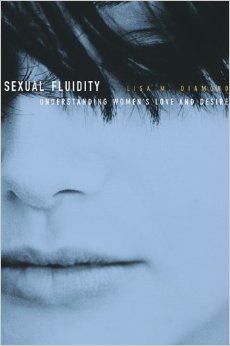This was a life-changing book for me. The only thing I can compare it to in terms of reading experience is Inseparable: Desire Between Women in Literature by Emma Donoghue, which opened up a whole world of queer women lit throughout time to me that I had never heard of before. Instead of changing my view of lesbian and bi books, though, Sexual Fluidity revolutionized my entire outlook on sexual identity and orientation.
I wish that was an exaggeration. This was an incredibly affirming book, but it also frustrated me that it took this long for me to discover a different framework from which to view sexuality–one that viewed my experiences not as an aberration, but as a normal, valid example of how sexuality might flow over time.
Lisa M. Diamond follows a group of almost 100 women over the course of ten years, most of them lesbians or bisexual women, checking in several times throughout to see how their sexual identity and behaviour had changed. Although the standard understanding of sexual orientation would assume that these women would stay in the same categories after they came out, this wasn’t the reality. 2/3 of the women changed identities (lesbian/bisexual/heterosexual/unlabeled) at some point during the ten years. Most of that change was because of sexual relationships women had since the last interview. Diamond argues that typically it isn’t actually that these women’s orientation is changing–the interviewees generally reported staying in a fairly narrow range of attraction to their preferred gender(s)–but that instead these experiences were due to examples of sexual fluidity.
This is a fairly academic text, but it’s packed full of fascinating information. It covers the biological aspects and psychological aspect of this concept, drawing from a huge amount of studies. I apologize for this long-winded review, because this book was so central in changing how I think about sexuality that I’m determined to note it all down so that I can’t forget.
Diamond argues sexual orientation indicates not a rigid prediction of the gender(s)/sex(es) you are and will always be attracted to, but instead indicated a range from which you can fluctuate–meaning that being attracted nonexclusively to a certain gender is not necessarily a bisexual orientation, but may be brought on by sexual fluidity. Basically, sexuality is not just a range from 0% same-sex attraction = heterosexual, 1%-99% same-sex attraction = bisexual, and 100% same-sex attraction = homosexual. Instead, orientation is only one aspect of sexuality. Here are some of the things she argues make up sexuality:
- Sexual orientation, which indicates a tendency to seek out sexual experience with a certain sex/sexes
- Degree of fluidity: the capacity a person has to react to triggers for fluidity. Where orientation determines someone’s already-existing attraction to certain sexes, same-sex arousability determines someone’s receptivity to environments that might trigger fluidity–like becoming emotionally intimate with a same-sex friend
- Exposure to environments that might trigger fluidity (usually exposure to certain genders/sexes in everyday life–an all-women college won’t offer a lot of opportunity for sexual fluidity towards men)
- Capacity for “person-based” attraction: for some people, emotional intimacy with someone may lead to romantic feelings, which may then lead to sexual attraction, just as sexual attraction to someone may then lead to romantic feelings for them
I know that I am over simplifying and likely mangling that explanation, but that is my understanding. Diamond also explores the roles of “proceptivity” (sexual drive) vs “arousability” (receptivity to sexual cues) in certain people’s lives. For people who menstruate, the hormonal fluctuations mean that arousability plays a bigger part in day-to-day attractions than proceptivity (unlike cis men).
She also explains that the biological foundation for romantic love evolved independently from sexuality. So while sexual orientation evolved to encourage mating, romantic love evolved from infant-caregiver bonding, which means that the biological underpinnings are not gender- or sex-specific, which explains why people might more easily fall in love with someone who does not match the sex they are usually attracted to. (These are systems that evolved separately, but they are connected, which is how romantic love might develop into sexual attraction and vice versa.)
Sexual Fluidity contains some pretty controversial statistics. For example, 60% of the women who identified as lesbians in the initial interviews went on to have sexual contact with men in subsequent years. More than 50% of the women who continued to identify as lesbians had sexual contact with men over the course of those ten years, and 30% of the women who identified as lesbians in the first interview would go on to have romantic relationships with men (though the vast majority of these women then stopped labeling themselves as lesbians). There seemed to be an unstated agreement that over 75% attraction to women meant you were a lesbian–people who crossed that line tended to change how they identified.
As someone who identified as a lesbian since high school, who felt at home in that label for ten years, and then found myself in a romantic relationship with a man, this was revelatory. Where I had always viewed my history of attraction as somewhat embarrassing and out of the ordinary, this recast it as perfectly valid and not even uncommon. According to this framework, it still made perfect sense that I would have a lesbian orientation but be in a relationship with a man (though I won’t call myself a lesbian anymore–I know that wouldn’t go over well). It just meant that I have capacity for fluidity, even though I have a pattern of being attracted to women. I can’t explain what a relief it was to read about my experiences as…. well, normal.
The conclusion of this book proposes that we change the way we look as sexuality, especially women’s sexuality. One promising avenue is dynamical systems, which in a psychology context means that it views a subject by acknowledging that biology and environment are constantly influencing and changing each other: it is a system that is based in change and assumes that change will happen, rather than seeing sexuality as a fixed point.
It’s important that we teach about sexual fluidity, because despite the fact that the majority of the women interviewed were affected in some way by fluidity, they usually explained these examples with some embarrassment, feeling as though they were the exception to the rule. Diamond shares that when she speaks at queer events about this research, she always has women come up to her afterwards and “confess” their experiences with fluidity, and how they had felt alone in this. We should not be teaching that perfectly normal shifts in sexuality or “exception to the rule” person-based attractions are abnormal.
This isn’t a perfect book. Diamond acknowledges that more research is needed, especially in the biological aspects that she mentions, which are often based on animal experiments. My primary criticism is the cissexism: gender and sex are conflated, which explains my muddled use of both in this review. Intersex people and nonbinary people are erased–despite the fact that two of the participants went on to identify as nonbinary in some way. And, of course, this is all based on interviews of people during a specific time period, and from a fairly narrow sample. It isn’t perfect, but it did blow my mind and make me consider my worldview, so I can’t help but give it 5 stars. If you have ever felt like your experiences don’t fit into the standard explanation of sexual orientation, I highly, highly recommend reading this one.




caseythecanadianlesbrarian says
Whoa, I gotta read this!!! It sounds like it will resonate with me as well.
Danika @ The Lesbrary says
For sure! I’d love to hear your thoughts on it! It definitely blew my mind while also making me feel so much better about my identity/history. Such a relief to read.